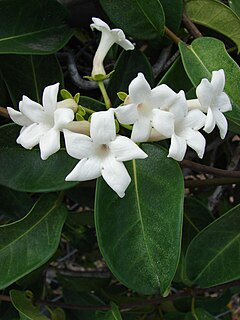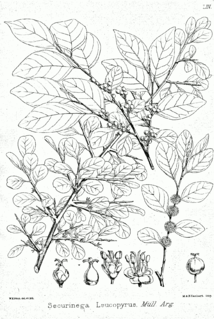| Securinega | |
|---|---|
 | |
| Securinega durissima | |
| Scientific classification | |
| Kingdom: | Plantae |
| Clade: | Tracheophytes |
| Clade: | Angiosperms |
| Clade: | Eudicots |
| Clade: | Rosids |
| Order: | Malpighiales |
| Family: | Phyllanthaceae |
| Subfamily: | Phyllanthoideae |
| Tribe: | Bridelieae |
| Subtribe: | Securineginae |
| Genus: | Securinega Comm. ex A.Juss. |
| Type species | |
| Securinega durissima | |
Securinega is a genus of plants in the family Phyllanthaceae, first described as a genus in 1789. [1] [2] As presently conceived, the genus is native to Madagascar and the Mascarene Islands in the Indian Ocean. In the past, it was considered to be much more widespread, thus explaining the long list of species formerly included. [3] [4] It is dioecious, with male and female flowers on separate plants. [5]
- Species [3]
- Securinega antsingyensis Leandri - W Madagascar
- Securinega capuronii Leandri - W Madagascar
- Securinega durissima J.F.Gmel. - Madagascar, Mauritius, Réunion, Rodrigues Island
- Securinega perrieri Leandri - W Madagascar
- Securinega seyrigii Leandri - W Madagascar
- Formerly included [3]
moved to other genera (Actephila Andrachne Chascotheca Cleistanthus Flueggea Jablonskia Margaritaria Meineckia Neoroepera Savia Tetracoccus )
- S. abeggii - Andrachne brittonii
- S. abyssinica - Flueggea virosa
- S. acicularis - Flueggea acicularis
- S. acidothamnus - Flueggea acidoton
- S. acidoton - Flueggea acidoton
- S. acuminatissima - Flueggea flexuosa
- S. bailloniana - Margaritaria discoidea var. triplosphaera
- S. buxifolia - Flueggea tinctoria
- S. capensis - Tetracoccus capensis
- S. congesta - Jablonskia congesta
- S. elliptica - Flueggea elliptica
- S. fasciculata - Tetracoccus fasciculatus
- S. flexuosa - Flueggea flexuosa
- S. fluggeoides - Flueggea suffruticosa
- S. grisea - Flueggea virosa
- S. guaraiuva - Savia dictyocarpa
- S. hallii - Tetracoccus fasciculatus var. hallii
- S. hilariana - Meineckia neogranatensis subsp. hilariana
- S. hysterantha - Margaritaria anomala
- S. japonica - Flueggea suffruticosa
- S. keyensis - Flueggea virosa subsp. melanthesoides
- S. leucopyrus (Willd.) Müll.Arg. 1866 - Flueggea leucopyrus
- S. leucopyrus Brandis 1874 - Flueggea virosa
- S. melanthesoides - Flueggea virosa
- S. melanthesoides var. aridicola - Flueggea virosa subsp. melanthesoides
- S. microcarpa - Flueggea virosa
- S. muelleriana - Neoroepera buxifolia
- S. multiflora - Flueggea suffruticosa
- S. neopeltandra - Chascotheca neopeltandra
- S. nitidaW.T.Aiton 1813 not Willd. 1806 - Actephila lindleyi
- S. obovata - Flueggea virosa
- S. phyllanthoides - Meineckia phyllanthoides
- S. ramiflora - Flueggea suffruticosa
- S. samoana - Flueggea flexuosa
- S. schlechteri - Cleistanthus schlechteri
- S. schuechiana - Flueggea schuechiana
- S. schweinfurthii - Andrachne schweinfurthii
- S. spirei - Flueggea spirei
- S. suffruticosa - Flueggea suffruticosa
- S. tinctoria - Flueggea tinctoria
- S. trichogynis - Meineckia trichogynis
- S. verrucosa - Flueggea verrucosa
- S. virgata - Flueggea tinctoria
- S. virosa - Flueggea virosa
- S. virosa var. australiana - Flueggea virosa subsp. melanthesoides




